For our 200th blog post we’re celebrating by focusing on the bounty of native spring flowers in bloom in the garden.
To see so many different native plants in bloom here this spring makes us feel as if all the hours spent weeding, and clearing debris, are really beginning to pay off. Keeping the weedy blackberry vines in check has allowed this Clintonia andrewsiana to bloom for a second year in a row.
Some of the natives have only been planted in recent months, but a number of them are endemic to the property. This is not a formal landscape by any degree. Instead, as we selectively remove the less desirable non-native species, we’re making room for more of the native plants that are already here to fill in. They grow where they will. There’s no order, no rhyme, no reason. It’s a wild garden, with a casual aesthetic, and we’re simply filling in the gaps between plants with other native annuals and perennials as we go.
Our endemic honeysuckle (Lonicera hispidula), no longer set back by browsing deer, it starting to take over some parts of the orchard and gardens, but we love it, and the bumble bees relish its flowers.
The endemic sticky monkeyflowers (Diplacus aurantiacus ssp. aurantiacus) are starting to put on their annual display of apricot-colored flowers on the drier slopes of the property.
These monkeyflowers are members of the Scrophulariaceae family, and like other Scrophularias they have bi-lobed stigmas that close in response to touch by a pollinator (or curious photographer).
Interestingly, the white globe lilies (Calochortus albus) are continuing to produce flowers quite late this spring. Those inside the deer fence have filled in tremendously this year, and are producing many more flowers per plant than last year.
The recently planted Salvia ‘Dara’s Choice’ seems to be very popular with the syrphid flies.
Encelia californica, one of our native sunflowers, is just beginning to bloom, and should continue to produce flowers at least through mid-summer. That is if the hoards of beetles attracted to it stop nibbling on the flower petals.
Ceanothus ‘Skylark’ may be the last of our Ceanothus to bloom this spring, but it’s providing a rich splash of blue in the border.
The native hedge nettles (Stachys bullata), which grow wild all over the property, are almost in peak bloom. We’ve been weeding around them since last year, and they’re filling in well.
In our last post I mentioned that the fennel in the herb garden was very popular with the lady beetles, but this morning I found more than a dozen of them on the flowers, buds, and leaves of Fremontodendron ‘Ken Taylor’ too.
The sulfur buckwheats (Eriogonum umbellatum polyanthum) are blooming far beyond our expectations. At least so far this buckwheat seems to be hardier than the pink-flowering buckwheat growing here.
Their yellow blossoms attract a wide range of pollinators, including beetles, butterflies, and of course our honey bees.
Blue-eyed grass (Sisyrinchium ‘E.K. Balls’) is producing masses of small purple flowers that open each morning, and close again before the sun sets.
Newly planted Verbena lilacina ‘de la Mina’ is just starting to bloom.
Salvia ‘Allen Chickering’ is performing far better than our Salvia ‘Winnifred Gilman’, which struggled to survive through this last winter, and is at risk of being replaced with this cultivar instead. This sage is doing remarkably well on the dry bank just below the bee hives.
Flowers in the Asteraceae family result in honey that crystallizes rapidly, however it was difficult to resist planting these native hairy goldenasters, Heterotheca villosa ‘San Bruno Mountain’, which are providing a vibrant splash of color on one of the dry steep slopes above the orchard, near ‘Allen Chickering’ above. This time of year with so many other flowers in bloom, these few blossoms are unlikely to adversely affect the quality of the honey though.
The flowers on our the endemic creeping snowberry (Symphoricarpos mollis) are starting to wind down for the season…
…as are the Western Star Flowers (Trientalis latifolia), which have filled in well this spring in the areas protected from the deer and rabbits. We’ll see them again next spring.
The woodland madia (Anisocarpus madioides) is beginning its profusion bloom somewhat earlier than last year.
It’s somewhat weedy in habit, and small drifts are now dotted around the orchard, but the native bees and various beetles seem especially attracted to it.
Most of the baby blue-eyes (Nemophila menziesii) are almost done for the spring, after blooming for the last six weeks.
The goldfields (Lasthenia glabrata) are winding down too.
A surprise in the garden this morning was a four foot tall Scrophularia californica that somehow we’d managed to overlook. In fact I almost walked right through it before I noticed it. After planting a single plant last year, a few rogue volunteers have appeared, but this is by far the tallest specimen we’ve seen. Honestly I had no idea it grew that tall!
Although not particularly spectacular in bloom, it has produced numerous tiny flowers, smaller than my pinkie finger nail, which are very popular with the tiny native bees, including the small carpenter bees (Ceratina sp.).
Last year after the Scrophularia bloomed, it was systemically mowed all the way down to the ground by Variable Checkerspot butterfly larva like this one…
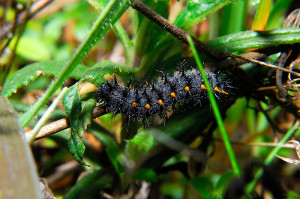
Scrophularia california is one of the host plants for Variable Checkerspot (Euphydryas chalcedona) larva
…so it will be interesting to see if this plant suffers the same fate.
Careful weeding in the wooded area at the edge of the orchard and garden has allowed the endemic Pacific Pea (Lathyrus vestitus) to fill in as a spring ground cover.
I’d much rather see this than the thuggish invasive hairy vetch that seems to show up all over the property. Once the blooms have faded, the foliage will die back again until the fall and winter rains return.
It’s exciting this spring to finally see so many plants in bloom, breaking up the expanse of green foliage here. Some of the plants are still quite small, but hopefully over the next few years, as these plants grow, and more are planted, we’ll have all this and more to look forward to each spring.
We won’t win any awards for garden design, as the landscape looks rather wild and natural, but we do seem to be winning the favor of various birds, bees, and other pollinating insects, and that is by far reward enough for us.


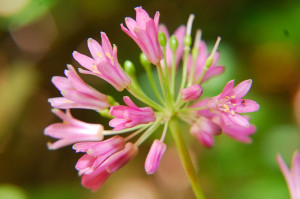
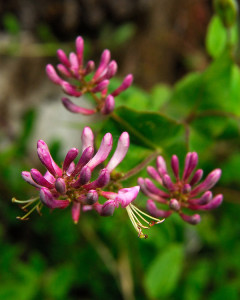
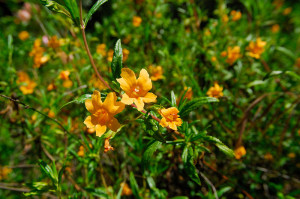
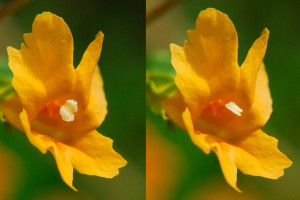
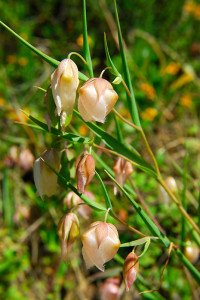
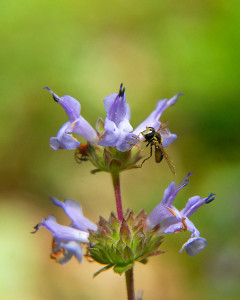
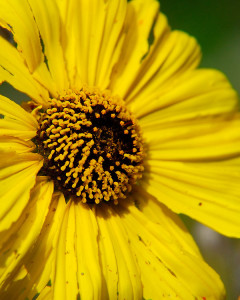
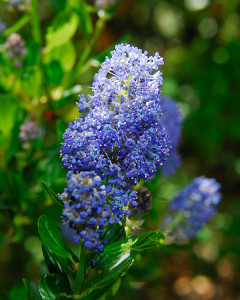
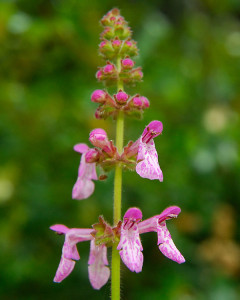
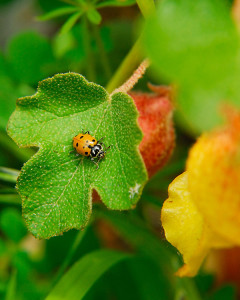

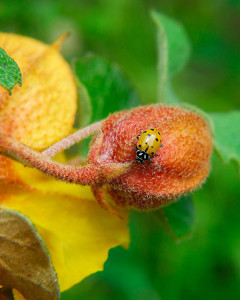

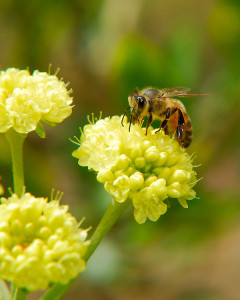

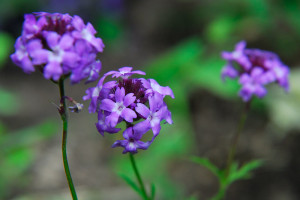

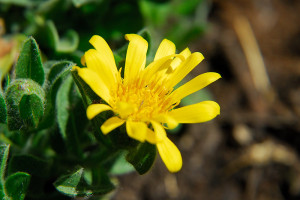
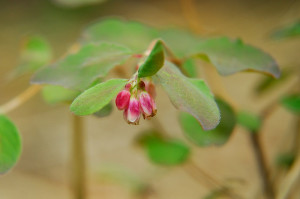

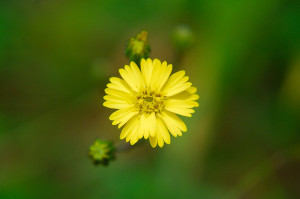
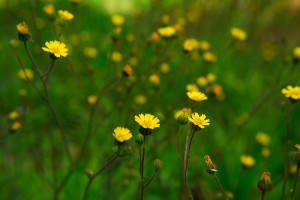
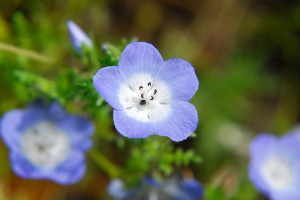
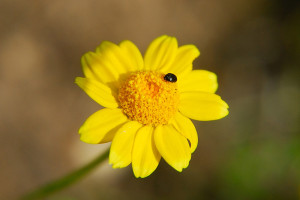










Congrats on post 200! What a milestone – and what great posts they all have been! I particularly enjoy your in-depth posts on individual species of flora or fauna – and also the chicken posts 🙂 Bee plant can get much taller than 4 ft! Since I started clearing weeds I’m seeing a lot more of it – Ya it will never be front-of border or even close – but it’s a great habitat plant and the leaves are quite pleasing, as well as the tiny vivid flowers. I haven’t seen so much “damage” this year from the checkerspot caterpillars – I was wondering if the weather had something to do with that. But they generally like to chomp on the bee plant – and good luck to ’em! Lovely blooms all round – thanks for sharing them!
Much taller than four feet? Good thing it’s in a place where that doesn’t matter 😉 We’ve seen so many Checkerspots in the garden this year, I’d expect there to be a bumper crop of larvae later in the season, but we’ll have to wait and see. I hope we get some, or this plant might turn into a monster!
Your spring natives are just so pretty. You have so many colorful ones. The tiny Wood rose is so lovely and so is the Honeysuckle. Does it get invasive like our Japanese Honeysuckle?
If you’d asked about the honeysuckle last year, I’d have said no. We had a few large vines, but the rest were small, and seemed to struggle to grow. That’s still true, outside the deer fence, but inside? I can’t believe how much they’ve grown. I wouldn’t call it invasive, but you do have to be sure to give it enough room to grow, because when it’s happy it has no trouble smothering smaller plants nearby. It’s beautiful though, and our native bumble bees really love it.
Hi,
Wonderful photos, I love the Honeysuckle’s wonderful pink shade, very pretty indeed. And I love how you’ve left the garden pretty much wild and are encouraging the natives. I’m not sure I could manage without some of my non-natives but it’s certainly something to aspire to!
We’re adding some non-natives to help carry the bees through late summer. Most of our California natives conk out by August, but the bees still need to gather food. We augment parts of the garden with plants that have similar conditions in regards to watering and soil, like lavender, and are planting more herbs like thyme and rosemary. Rosemary is great as it blooms here in winter, along with the native Manzanitas, when little else is in flower.
Lovely photos! I especially like the one with the bee on the Scrophularia californica. Of course the flower photos are beautiful as well. It’s safe to say your native flora is vastly different from ours here in Indiana.
I rather like that bee photo too, it was nice of her to cooperate for the camera 😉 I love seeing native plants from other regions, and am always impressed at the variety. I usually find them much more interesting than the generic plants you find at a garden center.
sticky monkeyflower! i love the blossom as well as the name. and your pictures are stunning as always… i too am infatuated with the bee on the scrophularia. congratulations on so very many really excellent posts.
I’d never seen (that I noticed) sticky monkeyflowers until the first year I lived here. It was quite a surprise seeing such vibrant blooms in an area that had just been green. The shrub almost looked like some sort of dwarf azalea, but you don’t usually associate azaleas with orange flowers! In some parts of the state the blooms may be yellow or even red, but this is the color of the classic form found here along our coast, and I love their cheery blooms.
It’s like you live in paradise. So lovely. Enjoy it and thanks so much for sharing.
Some days, when I’m not weeding, I think we do live in paradise 😉
Amazing diversity! Great photos too! Just a beautiful post!
Thanks Alan 🙂
You have such a wonderful range of wildflowers. It looks like all your weeding has paid off! I’d rather have all the diversity of bees, bugs and birds in your garden than an award any day! Beautiful post!
It is wonderfully rewarding seeing the faunal shift in the garden. This year we’re seeing lots of lady bugs, a much greater diversity of butterflies, dragonflies, bees, and nesting birds. We seem to be breaking out in goldfinches this year too, and we’d only ever seen a few here before. Really does make it all worth it.
Clare, So many fantastic native flowers and don’t they look lovely with their native bee and fly jewelry on! Dressed to thrill for those of us who love the pollinators. I didn’t know that about asteraceae and honey! I always learn something when I visit. Have a sweet weekend. gail
Well, almost. I went back out to that Encelia bloom yesterday afternoon, and most of its petals have been devoured. It was covered in little beetles. That one either needed more blooms, or less jewelry 😛
Love that scrophularia photo! Oddly, our bees totally ignore that plant. It’s kind of a messy gazork of a plant, and I’m not sure if I like it.
It certainly was a great spring for the baby blue eyes! I’m hoping ours will reseed.
And, hey! I love the re-design on the website. It was very attractive before, but this new look is even nicer. (And I’d never realized how very punctual you were with blog postings.)
Thanks Lisa. I think that scrophularia bee photo is destined to become my wallpaper. I’m amazed that after coffee I managed to hold the camera still enough for that to turn out 😛
I’ve been wanting to change the layout, and after some frustration with bugs in the template I was using before, I finally bit the bullet. I’m happy with how it’s turned out, I just need to tweak a few things, but so far I like it.
Clare,
I might be having problems posting comments here? You butterfly mentioned might be a Weidemeyer’s Admiral or California Sister, look in my archives in June of 2009 for my California butterflies.
It’s not a California Sister, we get hoards of those. At first glance I thought it was, except it had more orange. Lorquin’s was the closest I could find. It looks just like it, except for a row of orange spots along the hindwing edge. A variant perhaps? Mr. Curbstone took a photo with his phone. I could email it to you if it would help.
what a lovely diverse garden you have. AND I see you have the Blue eyed grass, I await patiently for springtime when mine blooms. Congrats on your 200th post!! Keep it up, I really enjoy your garden and e chickens!!!
I think blue eyed grass was one of my first native plant purchases. I love its flowers, and they’re so photogenic. Seems to do well even in partial shade here too.
On our walk yesterday, we saw lots of the stickey monkey flower and even quite a few globe lilies. We wouldn’t have know the name of the monkey flowers, and we probably would have entirely missed the globe lilies if it wasn’t for your blog. Thanks Clare!
So I can blame the last jar of crystallised honey on too many daisies in the bees diet ;~) I always choose fynbos honey. The alternative is invasive water guzzling eucalyptus – no thanks. Sometimes orange blossom …
So many of your plants look half familiar. We have daisy beetles, and beetle-daisies (with spots, and beetles!)
Congratulations on reaching your 200 milestone. What a wonderful array of flowers you have. I have tried to the Sticky Monkeyflower in my garden as I love the colour. Unfortunately it does not last very long. Which is why we should be growing our own native flowers I suppose 🙂
Clare your new blog layout is so refreshing and it must be lovely to see so many things coming into bloom just now and knowing that your bees will be so happy with all the different types of flowers on their own doorstep.
I’m sure I have some of the Scrophularia family in my garden so I must go and see if they too have that stigma.
Each of those little flowers on that hedge nettle really does look like a little orchid flower but my favourite has to be that woodland madia – I can just imagine golden drifts of that on your slopes. I love that photo of one of your clumps – it’s so beautiful.
200 posts! CONGRATULATIONS!!
BTW – I just fell in love with the Blue-eyed Grass. I couldn’t help it…
BTW – I love the updated formatting of your webpage! (I just popped over again from my blog link, instead of through Blotanical – from earlier today.)
Clare, I love seeing all your native flowers. The species of Clintonia that grows here (C. borealis) looks totally different; and although we have something that goes by the common name of “Blue-Eyed Grass” and looks similar, it seems to be a different genus.
BTW, congratulations on your 200th post and the fresh new look of your blog. -Jean
Oh, how lovely! I do think that this year’s late and abundant rains have brought about an especially impressive set of blooms. Can you believe a chance of rain in June? Love that Lonicera…
You have an interesting collection of plants in bloom right now. I am particularly taken with a number of the small flowered ones, Blue eyed grass, starflower, hedge nettle and pea.
What a lovely assortment of beautiful flowers. Weeding works.
Congrats on 200 great posts! I’ve learned so much here. I love seeing all your native flowers. I see that my little mystery flower is the Western Star Flower. I’ve found it since we lived here popping up around an old tree stump in our front yard. I had a feeling it wasn’t a weed, but never knew what it was so just let them spread. They are blooming right now.
Happy 200th, Clare! A stunning/informative post … we are very lucky to have you share your knowledge/beauty with us 🙂 Thank you.
Happy 200! What a joy for your readers to have followed you this far. You are an inspiration. I know the native plants are beautiful, and your practices are nourishing the earth and its wild inhabitants, not to mention a few humans, too!
Congratulations on 200 posts – which have all been chock-full of information and ideas. Because of your focus on regional natives, we have very few plants in common – in this post I think only Verbene. But that makes it all the more interesting. And your blog is so professional-looking.